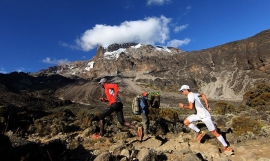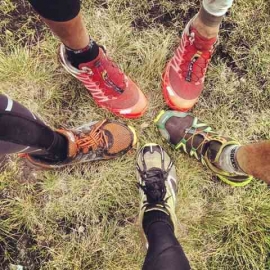Roy M. Wallack 出版书籍合集:
跑步书籍:
Barefoot Running Step by Step_Roy M. Wallack、Barefoot Ken Bob Saxton_2011
自行车书籍:
The Traveling Cyclist_Roy M. Wallack_1991
Bike for Life: How to Ride to 100_Roy M. Wallack_2005
Bike for Life: How to Ride to 100--and Beyond_Roy M. Wallack_2015
其他运动书籍:
Fire Your Gym! Simplified High-Intensity Workouts You Can Do At Home_Roy M. Wallack_2013
Healthy Running Step by Step: Self-Guided Methods for Injury-Free Running: Training-Technique-Nutrition-Rehab
Healthy Running Step by Step will help runners of all ages and abilities understand why running injuries occur, how to prevent them, and how to speed up recovery. Injuries plague the majority of runners, wrecking training plans and cutting running careers short by decades, but they are not inevitable. Authors Robert Forster, P.T., and Roy M. Wallack explain that nearly all running injuries can be rehabilitated quicker and even avoided altogether with the right training, strengthening, stretching, running form, and diet strategy.
Drawing from Forster's three decades of training and treating Olympic athletes and more than 10,000 runners at his award-winning Santa Monica, California, physical therapy and high-performance centers, this book emphasizes that better performance is inextricably bound to injury reduction and that a comprehensive, science-based training plan with built-in anti-injury "insurance" must include these crucial elements:
Periodization training
Proper technique and footwear
Nutrition
Posture and flexibility
Strength training
This book also includes detailed, step-by-step rehabilitation matrixes for the five most common running injuries: IT band syndrome, Achilles tendonitis, shin splints, plantar fasciitis, and hamstring injuries. Using these unique matrixes as your guide, you'll recover from injuries more quickly and understand what you need to do to prevent their reoccurrence.
Healthy Running Step by Step is a must-have guide if you've ever been injured, are recovering from an injury, want to prevent injuries, or run injury-free for decades to come.
Healthy Running Step by Step: Self-Guided Methods for Injury-Free Running: Training-Technique-Nutrition-Rehab Review
"Authentic, loaded with insight and information, Healthy Running Step by Step illustrates the scientific approach Bob used to help me and many others stay injury-free and achieve our ultimate Olympic goals." - Jackie Joyner Kersee, six-time Olympic medalist and multiple world record holder
"I'm fitter and more resilient as a 40-plus Masters runner than during my elite competitive career thanks to Bob. He helped me find an ideal healthy balance of technique, strength and flexibility, and nutrition, which I have used for rehabilitating the runners I now coach." - Jacqueline Hansen, Boston Marathon champion, two-time marathon world record holder
"Bob Forster is our secret weapon and a big part of our success. This book reveals all of the techniques and lessons learned over our eight Olympic Games together and is useful for athletes of all ages and abilities." - Bob Kersee, the most successful Olympic track and field coach of all time, with 44 medals
". . . presents a good, honest, common-sense plan gained from years of experience and results at the highest levels of the sport. If you're ready to end the running injury yo-yo for good, you'll be smarter and safer the second you open this book." - Rod Dixon, three-time Olympian and New York City Marathon champion
About the Author
Roy M. Wallack is a Los Angeles Times health and fitness columnist and former editor of Triathlete and Bicycle Guide magazines. A participant some of the world's toughest running, cycling, and multisport events, including the Boston Marathon, Badwater UltraMarathon, Eco-Challenge, La Ruta de los Conquistadores, and TransRockies Run, he finished second in the World Fitness Championship in 2004. Wallack has written for Outside, Men's Journal, Runner's World, Competitor, Bicycling, Mountain Bike, and authored The Traveling Cyclist: 20 Worldwide Tours of Discovery (1991) and Bike for Life: How to Ride to 100 (2005), an athletic longevity plan for cyclists.
Robert Forster, PT, has practiced Sports Physical Therapy in Santa Monica, CA, for 31 years. Robert has lectured throughout the US and Europe on Sports Rehabilitation and safety in exercise. Robert served as a private physical therapist at four Olympic Games for Olympians Jackie Joyner-Kersee, Florence "Flo-Jo" Joyner, Alyson Felix and their teammates who have won a combined 32 Olympic Medals under his direct care. He also worked pro athletes Pete Sampras, Kobe Bryant, Elton Brand, Maria Sharapova, as well as M.M.A. champions including B.J. Penn. Robert has published several articles in the scientific press and co-authored The Complete Water Power Workout Book published in 1993 by Random House. He has also written a regular column in Triathlete magazine, appeared in several episodes of the popular Fit to Hit series on the Tennis Channel and recently created the Herbalife 24 Fit Exercise Video for the world's leading weight loss company.
Healthy Running Step by Step: Self-Guided Methods for Injury-Free Running
Q: What type of runner is this book for?
A: All runners -- because there are two types of runners, the ones that have suffered injury and those who will in the future. Statistics show every year 37% of people running as little as 10 miles per week get injured and that number goes up to 57% for those running 50 miles per week. Over time every runner gets injured but most injuries are avoidable and this book explains the things runners need to do to stay healthy and what to do if they are already injured.
Q: What running subjects are covered in the book?
A: Everything a runner needs to run injury-free and be the best runner they can be. We explain when to run and for how far, when to rest and recover, and how to eat and drink to fuel your workouts and your life. The book includes a self-guided flexibility assessment and the 12 stretching and 12 'at home' strength exercise every runner needs to achieve proper mechanics and avoid injury.
Q: What makes this book different from other running books?
A: It is authentic. This book includes the specific programs and sports science that tens of thousands of runners, including many Olympians, relied on to produce some of the greatest running performances of all time. There are many running books but few look at health and performance from a long-term point of view.
Q: What unique perspective on running do you both bring (as authors/ experts)?
A: No one else combines total body physical therapy with the training and rehab of elite athletes like Bob Forster, whose all-star roster of athletes includes superstars such as Florence Griffith Joyner and Jackie Joyner Kercee. Roy Wallack was the first journalist to write extensively about the injury-reducing benefits of a running gait featuring a forefoot-landing and vertical armswing.
Q: Why do runners get injured so much?
A: The high incidence of running injuries is a result of a very repetitive activity in which the same joints and tendons are constantly under great stress. Any small imbalance, and we all have some, is magnified and concentrated step-after-step unlike it would be in other multidirectional sport or exercise activity.
Q: What can they do about it?
A: Runners need to understand how the human body responds to the stress of running and they will understand why all runners need a running plan governed by science and not whim. They need to understand the importance of stretching and foam roller work to help the body adapt to the repetitive stress of running.
Q: What are most runners doing wrong?
A: Runners fall into ruts doing the same workouts, the same distance and the same pace month after month. That is not how we train elite runners or any athlete for that matter. They are misled by unscientific fades and misinformation, the latest being you don't need to stretch or ice the things that hurt.
This book covers it all. It's easy to read and understand, while offering lots of information to help runners at all levels of ability, as well as non-runners thinking about getting started. It will get you ready to run with information aimed at helping you avoid the common pitfalls that many runners encounter. It will also help you understand how to recover from injuries that may occur, and steer clear of them going forward. This is the kind of book you will read and re-read. It’s not a read once and pass it on book; it is a great reference book that you will go to over and over again. Every runner, jogger, and even walker should own a copy of this book.
This may be the last running book I buy--(because I am 65 years old AND the book makes so much sense). I had originally borrowed it from the library, but I was checking it out so often, I finally purchased my own copy so that I could highlight passages and make notes to myself. When I borrowed it the first time, I discovered an injury description that I could have written--it pinpointed the way I felt. I have since been to the physical therapist and am on the mend. Forster hits the mark when he says you cannot "cherry pick" what you want to do when it comes to running and be able to stay injury free and healthy. He then maps out how to follow through. I highly recommend this book for runners of every age and ability level. I want to run forever, and this book may be my ticket to do just that!




